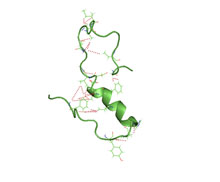Related Research Articles

The tau proteins form a group of six highly soluble protein isoforms produced by alternative splicing from the gene MAPT. They have roles primarily in maintaining the stability of microtubules in axons and are abundant in the neurons of the central nervous system (CNS), where the cerebral cortex has the highest abundance. They are less common elsewhere but are also expressed at very low levels in CNS astrocytes and oligodendrocytes.

Amyloid beta denotes peptides of 36–43 amino acids that are the main component of the amyloid plaques found in the brains of people with Alzheimer's disease. The peptides derive from the amyloid-beta precursor protein (APP), which is cleaved by beta secretase and gamma secretase to yield Aβ in a cholesterol-dependent process and substrate presentation. Aβ molecules can aggregate to form flexible soluble oligomers which may exist in several forms. It is now believed that certain misfolded oligomers can induce other Aβ molecules to also take the misfolded oligomeric form, leading to a chain reaction akin to a prion infection. The oligomers are toxic to nerve cells. The other protein implicated in Alzheimer's disease, tau protein, also forms such prion-like misfolded oligomers, and there is some evidence that misfolded Aβ can induce tau to misfold.

Amyloid-beta precursor protein (APP) is an integral membrane protein expressed in many tissues and concentrated in the synapses of neurons. It functions as a cell surface receptor and has been implicated as a regulator of synapse formation, neural plasticity, antimicrobial activity, and iron export. It is coded for by the gene APP and regulated by substrate presentation. APP is best known as the precursor molecule whose proteolysis generates amyloid beta (Aβ), a polypeptide containing 37 to 49 amino acid residues, whose amyloid fibrillar form is the primary component of amyloid plaques found in the brains of Alzheimer's disease patients.

Apolipoprotein E (Apo-E) is a protein involved in the metabolism of fats in the body of mammals. A subtype is implicated in Alzheimer's disease and cardiovascular diseases. It is encoded in humans by the gene APOE.

A neurodegenerative disease is caused by the progressive loss of structure or function of neurons, in the process known as neurodegeneration. Such neuronal damage may ultimately involve cell death. Neurodegenerative diseases include amyotrophic lateral sclerosis, multiple sclerosis, Parkinson's disease, Alzheimer's disease, Huntington's disease, multiple system atrophy, tauopathies, and prion diseases. Neurodegeneration can be found in the brain at many different levels of neuronal circuitry, ranging from molecular to systemic. Because there is no known way to reverse the progressive degeneration of neurons, these diseases are considered to be incurable; however research has shown that the two major contributing factors to neurodegeneration are oxidative stress and inflammation. Biomedical research has revealed many similarities between these diseases at the subcellular level, including atypical protein assemblies and induced cell death. These similarities suggest that therapeutic advances against one neurodegenerative disease might ameliorate other diseases as well.
The biochemistry of Alzheimer's disease, the most common cause of dementia, is not yet very well understood. Alzheimer's disease (AD) has been identified as a proteopathy: a protein misfolding disease due to the accumulation of abnormally folded amyloid beta (Aβ) protein in the brain. Amyloid beta is a short peptide that is an abnormal proteolytic byproduct of the transmembrane protein amyloid-beta precursor protein (APP), whose function is unclear but thought to be involved in neuronal development. The presenilins are components of proteolytic complex involved in APP processing and degradation.

Sortilin-related receptor, L(DLR class) A repeats containing is a protein that in humans is encoded by the SORL1 gene.

Michael Mullan is an English-American researcher in Alzheimer's disease and related neurodegenerative disorders. Mullan was a co-discoverer of genetic causes of Alzheimer's disease. Subsequently, he was a co-inventor on the original patents that covered three mutations in the amyloid precursor protein (APP) gene, a gene which is linked to familial Alzheimer's disease. He also co-authored articles in Nature and Nature Genetics, describing these three genetic errors; he was the senior author on two of those articles. Dr. Mullan co-discovered a specific genetic mutation, which became known as "the Swedish Mutation," because it was originally identified in DNA samples from two Swedish families whose members often developed early-onset Alzheimer's disease. These human genetic mutations were integrated into mouse DNA to create strains of mice that are being used worldwide to develop new drug treatments for Alzheimer's disease.

Presenilin-1(PS-1) is a presenilin protein that in humans is encoded by the PSEN1 gene. Presenilin-1 is one of the four core proteins in the gamma secretase complex, which is considered to play an important role in generation of amyloid beta (Aβ) from amyloid-beta precursor protein (APP). Accumulation of amyloid beta is associated with the onset of Alzheimer's disease.

Presenilin-2 is a protein that is encoded by the PSEN2 gene.

ATP-binding cassette sub-family A member 7 is a protein that in humans is encoded by the ABCA7 gene.

Triggering receptor expressed on myeloid cells 2(TREM2) is a protein that in humans is encoded by the TREM2 gene. TREM2 is expressed on macrophages, immature monocyte-derived dendritic cells, osteoclasts, and microglia, which are immune cells in the central nervous system. In the liver, TREM2 is expressed by several cell types, including macrophages, that respond to injury. In the intestine, TREM2 is expressed by myeloid-derived dendritic cells and macrophage. TREM2 is overexpressed in many tumor types and has anti-inflammatory activities. It might therefore be a good therapeutic target.

Transmembrane protein 106B is a protein that is encoded by the TMEM106B gene. It is found primarily within neurons and oligodendrocytes in the central nervous system with its subcellular location being in lysosomal membranes. TMEM106B helps facilitate important functions for maintaining a healthy lysosome, and therefore certain mutations and polymorphisms can lead to issues with proper lysosomal function. Lysosomes are in charge of clearing out mis-folded proteins and other debris, and thus, play an important role in neurodegenerative diseases that are driven by the accumulation of various mis-folded proteins and aggregates. Due to its impact on lysosomal function, TMEM106B has been investigated and found to be associated to multiple neurodegenerative diseases.

Alzheimer's disease (AD) is a neurodegenerative disease that usually starts slowly and progressively worsens, and is the cause of 60–70% of cases of dementia. The most common early symptom is difficulty in remembering recent events. As the disease advances, symptoms can include problems with language, disorientation, mood swings, loss of motivation, self-neglect, and behavioral issues. As a person's condition declines, they often withdraw from family and society. Gradually, bodily functions are lost, ultimately leading to death. Although the speed of progression can vary, the average life expectancy following diagnosis is three to twelve years.
Early-onset Alzheimer's disease (EOAD), also called younger-onset Alzheimer's disease (YOAD), is Alzheimer's disease diagnosed before the age of 65. It is an uncommon form of Alzheimer's, accounting for only 5–10% of all Alzheimer's cases. About 60% have a positive family history of Alzheimer's and 13% of them are inherited in an autosomal dominant manner. Most cases of early-onset Alzheimer's share the same traits as the "late-onset" form and are not caused by known genetic mutations. Little is understood about how it starts.

Rudolph Emile 'Rudy' Tanzi a professor of Neurology at Harvard University, vice-chair of neurology, director of the Genetics and Aging Research Unit, and co-director of the Henry and Allison McCance Center for Brain Health at Massachusetts General Hospital (MGH).

Phospholipase D3, also known as PLD3, is a protein that in humans is encoded by the PLD3 gene. PLD3 belongs to the phospholipase D superfamily because it contains the two HKD motifs common to members of the phospholipase D family, however, it has no known catalytic function similar to PLD1 or PLD2. PLD3 serves as a ssDNA 5' exonuclease in antigen presenting cells. PLD3 is highly expressed in the brain in both humans and mice, and is mainly localized in the endoplasmic reticulum (ER) and the lysosome.

Succinyl-CoA ligase [GDP-forming] subunit beta, mitochondrial is an enzyme that in humans is encoded by the SUCLG2 gene on chromosome 3.
Carlos Cruchaga is a human genomicist with expertise in multi-omics, informatics, and neurodegeneration, with a focus on Alzheimer's and Parkinson's Disease. He is a Professor of Psychiatry, Neurology and Genetics and Washington University School of Medicine. He is founding director of the Neurogenomics and Informatic (NGI) center at Washington University School of Medicine.

Carol Joyce Jennings was a British campaigner and advocate for research into Alzheimer's Disease. She served as an honorary Vice-President of the Alzheimer's Society until her death in 2024. Through her activism in the 1980s, Jennings brought her family to the attention of researchers studying the disease, which subsequently led to the discovery of the London Mutation. This mutation, found on the Amyloid Precursor Protein (APP) gene located on chromosome 21, marked a significant breakthrough in understanding the genetic basis of Alzheimer's Disease and provided evidence for the development of the 'amyloid hypothesis', which attempts to explain the underlying causes of Alzheimer's Disease.
References
- 1 2 "Alison M Goate". Icahn School of Medicine at Mount Sinai. Archived from the original on 23 October 2018. Retrieved 23 October 2018.
- ↑ "Huffington Center on Aging celebrates 30th anniversary". BCM Family. 5 November 2018. Archived from the original on 18 October 2019. Retrieved 18 October 2019.
- ↑ Goate, Alison (2008). "Interview". Biomarkers in Medicine. 2 (6). Future Medicine Ltd: 541–545. doi:10.2217/17520363.2.6.541. ISSN 1752-0363. PMID 20477443.
- ↑ Icahn School of Medicine at Mount Sinai. "Goate Lab". Icahn School of Medicine at Mount Sinai. Archived from the original on 2 September 2019. Retrieved 26 August 2019.
- ↑ Goate, Alison (December 2008). "Interview". Biomarkers in Medicine. 2 (6): 541–545. doi:10.2217/17520363.2.6.541. PMID 20477443. Archived from the original on 19 October 2019. Retrieved 19 October 2019.
- ↑ Goate, Alison (2 December 2008). "Interview with Alison Goate". Biomarkers in Medicine. 2 (6): 541–545. doi:10.2217/17520363.2.6.541. ISSN 1752-0371. PMID 20477443.
- ↑ "Announcements: Bob Lane Receives Lifetime Achievement Award". 1998. doi:10.1037/e404572005-032.
{{cite journal}}: Cite journal requires|journal=(help) - ↑ "National Academy of Medicine Elects 80 New Members". National Academy of Medicine. 17 October 2016. Archived from the original on 6 January 2017. Retrieved 18 October 2019.
- ↑ "RCF Announces Third-Annual Rainwater Prize Winners for Neurodegenerative Research". 14 December 2021.
- ↑ "Award for Dementia Researcher from New York City".
- ↑ US 5877015, Hardy, John Anthony; Chartier-Harlin, Marie-Christine& Goate, Alison Maryet al.,"APP770 mutant in Alzheimer's disease",published 1999-03-02, assigned to Imperial College of Science, Technology and Medicine
- ↑ US 5973133, Hardy, John A. &Goate, Alison M.,"Mutant S182 genes",published 1999-10-26, assigned to Washington University and University of South Florida
- ↑ US 6083694, Hardy, John &Goate, Alison M.,"Method for elucidation and detection of polymorphisms, splice variants, and proximal coding mutations using intronic sequences of the Alzheimer's S182 gene",published 2000-07-04, assigned to Washington University and University of South Florida
- ↑ US 6300540,Hardy, John Anthony; Chartier-Harlin, Marie-Christine& Goate, Alison Maryet al.,"Transgenic mouse expressing an APP-FAD DNA sequence",published 2001-10-09, assigned to Elan Pharmaceuticals Inc.
- ↑ "Espacenet – search results". worldwide.espacenet.com. Archived from the original on 16 March 2023. Retrieved 16 March 2023.
- ↑ US 8080371,Ballinger, Dennis; Konvicka, Karel& Bierut, Laura Jeanet al.,"Markers for addiction",published 2011-12-20, assigned to Washington University in St. Louis
- ↑ "Alison M. Goate, PhD - US grants". Neurotree. Archived from the original on 16 March 2023. Retrieved 15 September 2019.
- ↑ "RePORT ⟩ RePORTER".
- ↑ "RePORT ⟩ RePORTER".
- ↑ "RePORT ⟩ RePORTER".
- ↑ "RePORT ⟩ RePORTER".
- ↑ "Investigating MEF2C Transcription Factor as a Therapeutic Target to Reprogram Pathological Microglial States in Alzheimer's Disease".
- ↑ "RePORT ⟩ RePORTER".
- ↑ "RePORT ⟩ RePORTER".
- ↑ "RePORT ⟩ RePORTER".
- ↑ "RePORT ⟩ RePORTER".
- ↑ "RePORT ⟩ RePORTER".
- ↑ "RePORT ⟩ RePORTER".
- ↑ "RePORT ⟩ RePORTER".
- ↑ "Alison M. Goate - Semantic Scholar". www.semanticscholar.org. Archived from the original on 18 October 2019. Retrieved 18 October 2019.
- 1 2 3 4 5 6 "Google Scholar". scholar.google.com. Archived from the original on 16 March 2023. Retrieved 18 October 2019.
- ↑ Bierut, LJ (2012). "ADH1B is associated with alcohol dependence and alcohol consumption in populations of European and African ancestry". Mol Psychiatry. 17 (4): 445–450. doi:10.1038/mp.2011.124. PMC 3252425 . PMID 21968928.
- ↑ Hutton, M.; et al. (1998). "Association of missense and 5'-splice-site mutations in tau with the inherited dementia FTDP-17". Nature. 393 (6686): 702–705. Bibcode:1998Natur.393..702H. doi:10.1038/31508. PMID 9641683.
- ↑ Gitcho, M. A.; Baloh, R. H.; Chakraverty, S.; Mayo, K.; Norton, J. B.; Levitch, D.; Hatanpaa, K. J.; White Cl, 3rd; Bigio, E. H.; Caselli, R.; Baker, M.; Al-Lozi, M. T.; Morris, J. C.; Pestronk, A.; Rademakers, R.; Goate, A. M.; Cairns, N. J. (2008). "TDP-43 A315T mutation in familial motor neuron disease". Annals of Neurology. 63 (4): 535–538. doi:10.1002/ana.21344. PMC 2747362 . PMID 18288693.
{{cite journal}}: CS1 maint: numeric names: authors list (link) - ↑ Kauwe, John S. K.; Cruchaga, Carlos; Mayo, Kevin; Fenoglio, Chiara; Bertelsen, Sarah; Nowotny, Petra; Galimberti, Daniela; Scarpini, Elio; Morris, John C.; Fagan, Anne M.; Holtzman, David M.; Goate, Alison M. (2008). "Variation in MAPT is associated with cerebrospinal fluid tau levels in the presence of amyloid-beta deposition". Proceedings of the National Academy of Sciences. 105 (23): 8050–8054. Bibcode:2008PNAS..105.8050K. doi: 10.1073/pnas.0801227105 . PMC 2430357 . PMID 18541914.
- ↑ Bierut, L. J.; et al. (2008). "Variants in nicotinic receptors and risk for nicotine dependence". The American Journal of Psychiatry. 165 (9): 1163–1171. doi:10.1176/appi.ajp.2008.07111711. PMC 2574742 . PMID 18519524.
- ↑ Guerreiro, R (2013). "TREM2 Variants in Alzheimer's Disease". NEJM. 368 (2): 117–127. doi:10.1056/NEJMoa1211851. PMC 3631573 . PMID 23150934.
- ↑ Cruchaga, C (2013). "GWAS of Cerebrospinal Fluid Tau Levels Identifies Risk Variants for Alzheimer's Disease". Neuron. 78 (2): 256–268. doi:10.1016/j.neuron.2013.02.026. PMC 3664945 . PMID 23562540.
- ↑ Cruchaga, C (2014). "Rare coding variants in the phospholipase D3 gene confer risk for Alzheimer's disease". Nature. 505 (7484): 550–554. doi:10.1038/nature12825. PMC 4050701 . PMID 24336208.
- ↑ Kauwe, JS (2014). "Genome-Wide Association Study of CSF Levels of 59 Alzheimer's Disease Candidate Proteins: Significant Associations with Proteins Involved in Amyloid Processing and Inflammation". PLOS Genetics. 10 (10): e1004758. doi: 10.1371/journal.pgen.1004758 . PMID 25340798.
- ↑ Huang, Kuan-lin; et al. (2017). "A common haplotype lowers PU.1 expression in myeloid cells and delays onset of Alzheimer's disease". Nature Neuroscience. 20 (8): 1052–1061. doi:10.1038/nn.4587. PMC 5759334 .
- ↑ Kapoor, Manav; Wang, Jen-Chyong; Farris, Sean P.; Liu, Yunlong; McClintick, Jeanette; Gupta, Ishaan; Meyers, Jacquelyn L.; Bertelsen, Sarah; Chao, Michael; Nurnberger, John; Tischfield, Jay; Harari, Oscar; Zeran, Li; Hesselbrock, Victor; Bauer, Lance; Raj, Towfique; Porjesz, Bernice; Agrawal, Arpana; Foroud, Tatiana; Edenberg, Howard J.; Mayfield, R. Dayne; Goate, Alison (2019). "Analysis of whole genome-transcriptomic organization in brain to identify genes associated with alcoholism". Translational Psychiatry. 9. doi:10.1038/s41398-019-0384-y. PMID 30765688.
- ↑ Novikova, Gloriia; Kapoor, Manav; Tcw, Julia; Abud, Edsel M.; Efthymiou, Anastasia G.; Chen, Steven X.; Cheng, Haoxiang; Fullard, John F.; Bendl, Jaroslav; Liu, Yiyuan; Roussos, Panos; Björkegren, Johan LM; Liu, Yunlong; Poon, Wayne W.; Hao, Ke; Marcora, Edoardo; Goate, Alison M. (2021). "Integration of Alzheimer's disease genetics and myeloid genomics identifies disease risk regulatory elements and genes". Nature Communications. 12: 1610. Bibcode:2021NatCo..12.1610N. doi:10.1038/s41467-021-21823-y. PMC 7955030 . PMID 33712570.
- ↑ Kapoor, M.; et al. (2021). "Multi-omics integration analysis identifies novel genes for alcoholism with potential overlap with neurodegenerative diseases". Nature Communications. 12 (1): 5071. Bibcode:2021NatCo..12.5071K. doi:10.1038/s41467-021-25392-y. PMC 8379159 . PMID 34417470.
- ↑ Bowles, K. R.; Silva, M. C.; Whitney, K.; Bertucci, T.; Berlind, J. E.; Lai, J. D.; Garza, J. C.; Boles, N. C.; Mahali, S.; Strang, K. H.; Marsh, J. A.; Chen, C.; Pugh, D. A.; Liu, Y.; Gordon, R. E.; Goderie, S. K.; Chowdhury, R.; Lotz, S.; Lane, K.; Crary, J. F.; Haggarty, S. J.; Karch, C. M.; Ichida, J. K.; Goate, A. M.; Temple, S. (2021). "ELAVL4, splicing, and glutamatergic dysfunction precede neuron loss in MAPT mutation cerebral organoids". Cell. 184 (17): 4547–4563.e17. doi:10.1016/j.cell.2021.07.003. PMC 8635409 . PMID 34314701.
- ↑ Tcw, J.; Qian, L.; Pipalia, N. H.; Chao, M. J.; Liang, S. A.; Shi, Y.; Jain, B. R.; Bertelsen, S. E.; Kapoor, M.; Marcora, E.; Sikora, E.; Andrews, E. J.; Martini, A. C.; Karch, C. M.; Head, E.; Holtzman, D. M.; Zhang, B.; Wang, M.; Maxfield, F. R.; Poon, W. W.; Goate, A. M. (2022). "Cholesterol and matrisome pathways dysregulated in astrocytes and microglia". Cell. 185 (13): 2213–2233.e25. doi:10.1016/j.cell.2022.05.017. PMC 9340815 . PMID 35750033.
- ↑ Podleśny-Drabiniok, Anna; Novikova, Gloriia; Liu, Yiyuan; Dunst, Josefine; Temizer, Rose; Giannarelli, Chiara; Marro, Samuele; Kreslavsky, Taras; Marcora, Edoardo; Goate, Alison Mary (2024). "BHLHE40/41 regulate microglia and peripheral macrophage responses associated with Alzheimer's disease and other disorders of lipid-rich tissues". Nature Communications. 15: 2058. Bibcode:2024NatCo..15.2058P. doi:10.1038/s41467-024-46315-7. PMC 10917780 . PMID 38448474.